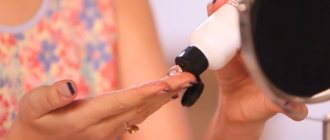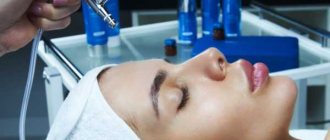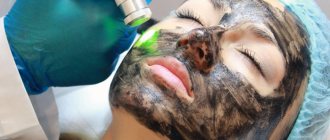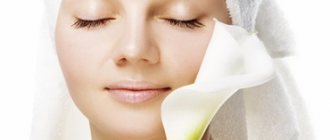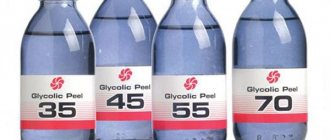Ladies who want to look young and well-groomed will certainly appreciate Rose de Mer peeling (an alternative name is coral peeling). This skin cleansing is remarkable for its intensity and effectiveness. At the same time, coral cleansing products are considered gentle and do not contain such aggressive components as chemical exfoliants. Rose de Mer is an exclusively natural and natural procedure. Who is this gentle peeling suitable for? What to expect from this exfoliation option and how to care for your face after the procedure? And in what cases will coral cleaning do more harm than good?
Rose de Mer coral peeling for face: what is it?
Coral peeling
– one of the types of mechanical exfoliation and skin cleansing. This method is used in cosmetology clinics and salons as an alternative to harsh chemical peels.
The procedure is most often performed using the professional line of Rose de Mer products from Christina (Israel), combining the properties of mechanical skin cleansing and the benefits of chemical peeling. The coral peeling procedure is suitable for people with different skin types; it can be performed on patients of all ages and at any time.
Rose de Mer peeling occurs without skin burns, eliminates protein coagulation, but causes painful sensations of varying strength, which manifest themselves individually. With coral peeling, the upper keratinized layers of the epidermis are removed, which allows solving cosmetic problems associated with acne, pigmentation, premature aging, etc.
Israeli cosmetologists have proven that it is the combination of the properties of all the peeling components that gives excellent results, even in resolving subcutaneous hemorrhages and strengthening the walls of capillaries, which helps eliminate blood stagnation, improving complexion. During the procedure, the epidermis is saturated with microelements, which are part of the gifts of the Dead and Red Sea, and plant acids contribute to the vigorous functioning of the subcutaneous structures of the skin.
There are two types of Rose de Mer peeling powder
• Light – light peeling
, containing large quantities of plant extracts and extracts, which is used for shallow penetration. It has the property of stimulating healing, increasing skin immunity. Improves complexion and relieves inflammation. Suitable for a “weekend” procedure. Dilute in a ratio of 1 to 1, apply to the entire face for 5 minutes, do not rub in. Gives good results when combined with mechanical and ultrasonic facial cleansing.
• Deep – cleaning with deeper penetration
and active peeling. This is a classic peeling, which is an alternative to chemical peeling.
A special feature of the peeling procedure using Rose de Mer preparations is that one product with different methods of application makes it possible to flexibly approach the elimination of cosmetic imperfections (due to rubbing).
Classic coral peeling can be performed in 2 options:
EPi 1 - exfoliation
, only the stratum corneum is affected, exposure time is 2 minutes;
EPi 2
— penetration to the granular layer, exposure time from 5 to 10 minutes depending on the thickness of the skin.
Efficiency of application
Coarse particles of coral and salt have good grinding abilities. The procedure allows you to cleanse the surface of the skin by removing the upper stratum corneum. This leads to a leveling of the relief: a decrease in the depth and severity of wrinkles, scars, and bumps. The number of interventions to achieve an effect depends on the severity of the problem.
The exfoliating effect of the scrub is similar to a massage. After the procedure, impaired blood circulation and lymph flow are restored. Proper muscle function is stimulated, metabolic processes return to normal. The skin looks fresh, tightened, healthy. The effect is noticeable after a single session. A neglected situation will require a course of intervention.
Coral peeling allows you to lighten age spots and freckles. After a single treatment, dark areas become less noticeable. A course of interventions (3-4 sessions) will help to completely get rid of the uneven shade. This is only possible in combination with regular sun protection: you will need to use a cream with UV protection.
The procedure helps to narrow enlarged pores and normalize the activity of the sebaceous glands, which has a positive effect on the quality of the skin. The integument becomes attractive in appearance: more even, matte. The predisposition to frequent rashes disappears (if the destructive process is not related to health). Acne and comedones are cleared in 1-2 sessions; acne treatment requires a course of interventions.
Indications and contraindications for Rose de Mer peeling
Indications
• treatment of active acne of any severity and different locations
• prevention of post-acne or treatment of complications: infiltrates, scars, stagnant spots, etc.
• getting rid of stretch marks, scar formations, including after pregnancy
• reduction of enlarged pores
• removal of hyperpigmentation of any etiology: hormonal, post-peeling (laser, phenol, ANA, TSA), etc.
• combating sun damage to the skin: keratoses, excessive dryness, loss of elasticity
• rejuvenation of the face, neck, hands, décolleté, etc.
The use of coral peeling helps with premature aging of the skin, the appearance of fine wrinkles, sagging, loss of turgor and tone. This type of cleansing can be carried out both on sensitive skin with rosacea and on problematic oily skin. Peeling Rose De Mer is indicated for the treatment of the most advanced acne.
Contraindications
• External damage and violation of the integrity of the skin • Acute stages of viral and infectious diseases • Taking vitamin A derivatives • Individual intolerance to the components of the peeling composition • Herpes in the acute stage • Pregnancy, breastfeeding • Increased body temperature, etc.
Coral peeling is one of the safest types of deep cleaning. If all contraindications are taken into account, such a procedure can even be carried out at home. For this purpose, the Rose de Mer line from Christina has been released, containing products for peeling and post-peeling care: soap peeling (natural soap containing coral powder), post-peeling foundation containing red clay, as well as a set for post-peeling care, including gel, serums , cream, masks.
Question answer
Today drugs can be purchased in specialized online stores, so many women prefer to perform the procedures at home.
You should first consult with a cosmetologist. If you have previously had herpes in the lip area, then you should take a whole course of antiviral drugs before peeling. In addition, for 2 weeks it is better to protect yourself from sunbathing in the sun or in a solarium.
After one session, of course, the effect will be visible. But to get the best result and get rid of specific problems (pigmentation, scars), it’s worth taking a course. Usually cosmetologists advise about 4-6 procedures.
Pros and cons of Rose de Mer
Unlike exfoliation using fruit acids, the Rose de Mer method is a medium peeling. The procedure is a worthy alternative to more traumatic treatments such as deep chemical peels. Coral peeling is recommended if you are intolerant to chemical peeling or have contraindications to other methods of cleansing or dermabrasion, thanks to its herbal anti-allergenic composition.
The advantage of coral peeling is gentle mechanical cleansing of the skin with a simultaneous stimulating, softening, antibacterial effect, which allows it to be used even on sensitive skin. But coral cleansing is also not completely atraumatic, because it actively affects the surface and middle layers of the skin.
A distinctive feature of Rose de Mer from other types of peeling is the ability to control the depth of penetration of the active substance, which allows for superficial or deep cleaning, depending on the indications and wishes of the patient.
Many types of peeling are contraindicated for persons with manifestations of rosacea and other vascular changes. Peeling with coral chips is allowed for such cosmetic defects.
Positive biostimulation, cells do not die immediately as with chemical peels, but within 2 days, sending a signal to the basement membrane. Consequently, the cell renewal mechanism is launched.
The result and depth of impact does not depend on, as with chemical peels, but depends on the time of rubbing in the peeling composition.
After the procedure, the texture and complexion of the face noticeably improve, but Rose de Mer still cannot cope with deep wrinkles.
During the procedure, painful sensations arise, sometimes very strong.
Several procedures are required to achieve a visible effect.
Peeling Rose de Mer - before and after photos
COMPOSITION AND BENEFITS OF COMPONENTS
Marine exfoliants combine mechanical and chemical effects due to their complex composition:
- Coral particles;
- Amazon seaweed extracts;
- Chlorophyll;
- Healing herbs;
- Dead Sea salts;
- Proteins of plant origin;
- Vitamins and minerals;
- Organic acids;
- Essential oils.
Pros : this composition simultaneously normalizes the level of sebum, improves blood circulation, exfoliates the stratum corneum, disinfects, rejuvenates and moisturizes.
Cons: during the session you will have to put up with the unpleasant “fishy” smell of the drug.
What skin problems does it solve?
A healthy epidermis is renewed monthly. However, a polluted atmosphere, poor quality nutrition, natural aging and other factors slow down the replacement of old cells with new ones.
This is relevant not only for the face, but also for the décolleté, neck and back of the hands, where this type of peeling can be used.
Exfoliation with abrasive particles helps clean pores and normalize oxygen supply to the skin, which provides a slight lifting effect. Microtrauma additionally activates the production of collagen protein.
Unlike peelings with a predominance of acids, coral cleansing is suitable for patients of any age, gender and skin type (even dark-skinned people, who usually run the risk of “staining” after “chemistry”).
For those with sensitive skin, the procedure helps to cope with the problem of constant allergic reactions : crushed coral crumbs provoke allergic rashes much less frequently than most other ingredients in cosmetology.
Where it will be useless and harmful
Despite the versatility of coral peeling, it is worth abandoning this method of exfoliation if at least one of the contraindications is detected:
- Hypersensitivity;
- Individual intolerance (you should first undergo allergy tests);
- Herpes in the last 6 months before the session (as a last resort, you can take a course of antiviral drugs 3-4 days before);
- Open wounds in the intended area of influence;
- Demodicosis (it is necessary to ensure in advance that there are no subcutaneous parasites through a 5-minute laboratory scraping with an instant result);
- Skin infections;
- Taking retinoids (vitamin A derivatives);
- Acne in the active stage (otherwise the infection may spread throughout the entire treatment area);
- Cuperosis (spider veins can be dealt with in this way only under the guidance of an experienced cosmetologist and during their remission, otherwise the network of capillaries only expands after exposing the deeper layers of the skin);
- Pregnancy (difficult to predict the result);
- Fresh tan (up to 2 weeks);
- Nervous disorders , increased fatigue, poor pain tolerance, emotionality, PMS period.
It is also undesirable to resort to coral cleansing during periods of active sun.
We recommend: PEELING OR FACIAL CLEANING: WHAT IS BETTER? | 5 differences
Properties of the active component of Rose de Mer preparations
In the production of coral peeling products, exclusively herbal ingredients are used. The main component is coral chips
, which acts like microdermabrasion, i.e. it cleanses the upper and middle layers of the skin. Red Sea corals are used, and the crushed powder contains corals of different stages of their development: young ones have a stimulating effect on the skin, and old ones are used as mini-needles that penetrate the skin to activate blood circulation and cleanse, being rejected along with the surface “dead” layer .
Additional, but no less important, components are Dead Sea salts and rare plants from the Amazonian lowland, from which essential oils and beneficial substances are released.
Medicinal herbs from Brazil are subjected to deep freezing and rapid drying, which greatly enhances their biostimulating properties. Raw materials prepared in this way can be stored for a long time without the use of preservatives. Coral peeling contains minerals, trace elements, proteins from herbal extracts, chlorophyll, plant acids, vitamins C, E, etc.
This composition allows for gentle cleansing of the skin, saturating it with useful microelements. If the basis of the peeling - coral chips - acts as an exfoliating part of the mixture, then Dead Sea salts, extracts from rare herbs of Brazil, and their essential oils provide a softening effect for speedy skin renewal.
The basic principle of action of Rose de Mer preparations:
1. Crushed corals act as micro-resurfacing
2. Sea salt dehydrates skin cells, promoting their rejection
3. Plant components have regenerating, biostimulating effects
Rose de Mer preparations promote optimal penetration of active ingredients into the skin, therefore they are indicated for various cosmetic problems. The combination of a light massage and coral peeling ingredients causes stress and microtrauma of the skin, which provokes the natural renewal of collagen fibers. The skin quickly gets rid of dead cells, rejecting them. The level of humidity is restored, the process of collagen synthesis is resumed, and the structure of the entire epidermis is improved.
At home
In this case, you need clear confidence that you are able to properly carry out the peeling procedure at home in order to avoid negative consequences
To do this, it is important to adhere to the following rules
Preliminary stage
Using peeling soap, thoroughly cleanse the skin. This is necessary for:
- Preparing tissues for the peeling procedure;
- Anti-inflammatory effects;
- Primary exfoliation of “old” particles of the epidermis;
- Opening of comedones;
- Balancing the secretion of the sebaceous glands.
Main stage
It all depends on the choice of peeling method and product.
Gentle peeling to target the surface layer of the skin:
- Dilute the powder with the activator in a 1:1 ratio;
- Apply the resulting mass to the surface to be treated;
- Keep the mixture on your face for 5 minutes;
- There is no need to rub this peeling product into the skin.
Classic peeling is performed according to the following scheme:
- Dilute the powder with the activator in a 1:1 ratio;
- Apply the resulting mass to the face, strictly avoiding areas around the eyes and lips;
- Rub in with gentle movements for two minutes to affect the stratum corneum of the skin, for 5-10 minutes to penetrate to the granular layer of the skin.
Final stage
It consists of a set of procedures that are performed after peeling and includes the use of a mask, gel and cream. It is advisable that all products be from the same cosmetic line
It is important to follow the following technology:
- We carefully apply a soothing mask for an absorbent effect, it will absorb excess oil, relieve some irritation and tighten pores;
- Now we move on to the gel, which will protect the skin from subsequent pollution and retain the active components of the peeling inside the pores;
- Further, the antibacterial and antifungal properties of the protective cream, including for masking skin defects;
- Additional medications may be used to better protect the skin after such procedures.
Pre-peeling preparation
Some cosmetologists recommend doing ultrasonic or mechanical facial cleansing a few days before coral peeling to cleanse clogged pores. But many doctors working with Rose de Mer professional cosmetics use a special antiseptic soap immediately before the peeling session.
To do this, apply a small amount of liquid disinfectant soap to the face and massage it over the entire surface. An important function of this process is precisely preparing the skin for better exfoliation and protecting it from microdamage. Then the soap is washed off and the doctor begins to prepare the peeling composition and apply it to the treated area.
Is the procedure done in salons?
Cosmetologists successfully use peeling soap for professional care. The procedure is prescribed for oily, thick, problem skin; in rare cases, it is used for dry, sensitive skin.
Only a specialist, after assessing the condition of the skin, can recommend the use of the program and include additional care products. A pronounced effect is observed after visiting a cosmetologist, who selects the optimal system of procedures to solve individual problems.
Home care can also bring the desired result. But to restore oily, problematic or dehydrated skin, using one product is not enough.
Daily systematic cleansing, moisturizing, toning, periodic use of masks and scrubs will normalize the condition of the dermis. A cosmetologist can select the optimal products during a consultation, depending on your skin type.
The salon offers 2 types of coral peeling, superficial and medium. It is prescribed to eliminate pigmentation, get rid of stretch marks, stretch marks, treat acne of any degree, and rejuvenate the skin. The cost of a session is from 2000 rubles, the quantity is determined individually, on average the course consists of 5–8 procedures.
Stages of coral peeling
To achieve the effect, only one procedure is rarely enough, although a single coral peeling provides a significant renewal of the upper layer of the skin. Professional cosmetologists recommend at least 4 sessions with an interval between them of about 6-8 weeks for oily thick skin and after 3 months for other skin types with EPi 1.
At the first stage, a composition is prepared, including powder from old and young corals and a special activator from an extract of algae, sea salt, and minerals in a ratio of 1:2. The resulting mixture is applied in a uniform layer to the treated area, excluding the area around the eyes. Using massage movements, the skin is exposed for 2-4 minutes for superficial treatment and 5-10 minutes for medium peeling.
After this, the client must be given a wet compress to prevent the mixture from drying out and left for 10-15 minutes. At this time, an active process occurs, accompanied by tingling, pinching, and burning.
Then the dirty green composition is washed off with cold water using gauze or damp sponges. Sometimes cosmetologists use serum with hyaluronic acid: “beauty balls” have a soothing effect on the skin.
At the last stage, a protective gel is applied to consolidate the result and a protective cream that helps cope with the redness of the skin, softening and providing an antimicrobial effect.
You can treat only one zone in one procedure; the next zone is started after 1 week. Ask the client about the sensations and whether you are rubbing the peeling composition with the same force.
The procedure must be performed with gloves.
The coral peeling procedure in the beauty salon is completed, but the active process will last another 4-5 days. On the first day, the skin acquires a reddish-brown tint, tightness appears, and in many cases pain when touched (burning sensation).
After 2-3 days, a film forms and the top layer of skin begins to crack and peel. Scales of various, sometimes quite large, sizes fall off on their own within 4-5 days; they cannot be separated independently. Many cosmetologists offer patients to undergo a procedure for exfoliation and skin regeneration on the 5th day after coral peeling.
There may be a slight shift in time, because the skin has different degrees of oiliness and thickness of the epidermis, due to which it reacts differently to the procedure.
When should you not peel?
Any product has its contraindications. It is important to know about them:
- The procedure cannot be performed if the integrity of the skin is damaged.
- During the course of viral diseases (acute stages).
- It is not recommended to do peeling while taking vitamin A and its derivatives.
- If a herpes rash is visualized.
- Intolerance to one of the components.
- You cannot use a cosmetic product when your body temperature is elevated.
- Peeling is not recommended by doctors for women who are preparing to become mothers.
Skin care after peeling Rose De Mer
After the cleansing and exfoliating process with coral chips, here are some skin care tips to follow:
• do not scratch the skin when peeling
• when exfoliating extensively, do not remove the scales yourself; you can carefully cut them off with nail scissors
• constantly use moisturizing sunscreens with UV filters and protection of at least 30
• for at least 1 week it is not recommended to visit the sauna, bathhouse, avoid exposure to steam, do not expose the treatment area to high temperatures
• for about 1.5-2 weeks it is advisable to avoid exposure to active ultraviolet rays: both in the open sun and in a solarium
• do not use products with alphahydroxy acids and retin-A during the entire peeling period
As home care on the first day after peeling, it is recommended to wash with boiled water and antiseptic soap, rinse with acidified water, and thermal water is also good. After gentle drying, you can apply a serum or cream with hyaluronic acid, which will preserve the natural moisture of the skin.
It is better to start using moisturizing and nourishing creams on the 3rd third day, when peeling begins. To speed up this process, you can make a warm, damp compress with mild soap, and then massage with a special cream or Vaseline and carefully wash everything off.
It is best to purchase a special home series of post-peel care “Rose de Mer Post-Peel Kit” from Christina. The products from the set should be used within 3-4 days after peeling.
Aftercare
This point is also important. A couple of days after the peeling session, the skin requires special care. Experts recommend using products intended for post-peeling rehabilitation. They should have a moisturizing, softening, and regeneration-stimulating effect. Typically, salons warn their clients that during this period they should postpone the use of drugs containing glycolic acid. It is also necessary to use creams with a high degree of sun protection.
Possible complications
During coral peeling, the skin heats up and turns red, and the patient may experience quite strong painful sensations: from mild tingling to severe stinging. The degree of discomfort depends on the sensitivity of the skin and the depth of exposure, and unpleasant feelings when touched can last for several hours after peeling.
There are usually no complications after the Rose de Mer procedure. The changes that occur to the skin in the first 4-5 days pass, and the patient receives rejuvenated, refreshed skin. Complications that may still arise are common to all types of peeling: allergies, hyperemia, swelling, pain, increased skin sensitivity, infection. See more details here.
Women's opinions
Reviews of the Rose De Mer peeling are mostly positive. After the first procedure, women note an improvement in their skin condition. As a result, they got rid of pigmentation, wrinkles and acne decreased.
For minimal skin problems, one procedure is enough. If a woman has enlarged pores, hyperpigmentation, or numerous pimples, then coral peeling is performed 2 to 4 times.
The second category of girls notes that redness, burning and swelling persisted on the skin for a week. It was very difficult for them to endure the pain, and the effect of the procedure was minimal.
Cost of the Rose de Mer procedure
Coral peeling can be performed on the face, neck, hands, décolleté, etc. The most popular service is facial peeling, which has different costs, depending on the qualifications of the cosmetologist, the prestige of the salon, etc.
The procedure, performed using professional cosmetics Rose de Mer from Israel from the company Christina, will cost from 1500-2000 rubles (minimum) to 4000 rubles. and more. When treating the face and neck, you will have to pay from 2000-3000 rubles.
If you order a coral peeling for face + neck + décolleté, then together with post-peeling care, which they offer to buy in beauty salons (mini-packages), it will cost from 3,000 to 6,000 rubles or more.
Tags: other
Market Analytics
- 2020 in the beauty industry – innovation without borders
- Black Lives Matter movement: reaction and consequences for the beauty industry
- COVID-19 is changing the rules of the game in the cosmetics market
Convenient search for beauty salons on our website
Beauty salons in Moscow Beauty salons in St. Petersburg Beauty salons in Ekaterinburg Beauty salons in Novosibirsk
Latest blog posts on our website
- Naturecream / Arnica - the magical plant of alchemists
- Naturecream / Tremella Extract - Snow Mushroom Detox for Skin
- Prostye-sovety / How to visually enlarge your lips with makeup
- Naturecream / Apricot kernel oil for face
- Naturecream / MATRIXYL3000 - the best skin elasticity stimulator
- Naturecream / SPF in Natural Oils
- Naturecream / Geranium (Pelargonium) oil for skin health and beauty
- Prostye-sovety / Save on a beauty salon: procedures that can be done at home
- Naturecream / Growth Factor - brings back youth?
- Oksana-Lezina / 3 effective abdominal exercises from a fitness instructor for beginners
Latest forum topics on our website
- Natalya / How to properly make a gelatin mask?
- Mrs._Smith / Badly sunburned! What to do?((
- Ice / Is it necessary to combine fitness classes with a diet?
- Antonova / What can be used for hair loss?
- Radio operatorKat / Who was on a protein diet?
Reviews of the Rose de Mer coral peeling procedure for the face
- Lelya | 2014-02-09 12:15:33 After coral peeling, what I don’t like most is the dry skin after the procedure, as if you were wearing a mask and there are peels that you just want to tear off and of course the feeling during the procedure, it looks like it’s prickly and painful. But I like the result: rejuvenated, renewed skin.
- Karina |
2014-02-07 18:13:56 I can’t do chemical peels, I was allergic to glycolic acid. The cosmetologist advised me to do coral peeling. I have already done the second procedure and am quite pleased with the result. During the procedure, the cosmetologist gives a fan so that it doesn’t hurt so much, and she washes off the peeling herself. The result is a good complexion, evened out, stagnant spots have disappeared, pores have become less pronounced.
[Leave a review]
Leave your review of this procedure (it will appear on this page after moderation)
In this form, describe only
your personal
experience of undergoing the procedure.
In order to leave a comment regarding the content of the article, use another form - in the “comments” block at the bottom of the page.
Other articles in this section
| Phenol peeling for the face Phenol peels refer to skin exfoliation procedures performed using carbolic acid (phenol). Deep peeling affects all layers of the epidermis, right down to the papillary layer. The extreme length of the rehabilitation period, reaching 12 months in some cases, and the high risk of severe complications require a particularly careful approach. |
| Homemade facial peels that you can buy in a store Any woman who wants to take care of her health and appearance can resort to a facial peeling procedure. It will not be superfluous to restore the normal functioning of skin cells due to age or illness, as well as to eliminate the manifestation of various undesirable phenomena, such as enlarged pores or wrinkles. |
| Phytic peeling for the face Peeling with phytic acid in some salons is also called “Hollywood peeling” because it came to us from the USA. It is very popular there, since it can be used at any time of the year and does not require a long rehabilitation period, that is, you can work and appear in public immediately after the procedure. Phytin peeling has proven itself best as a peeling that combats the problems of mature skin with rosacea. |
| Arginine peeling for the face One of the types of chemical peelings is arginine peeling, which rejuvenates and moisturizes the skin, has a mild exfoliating effect, and prevents the appearance of the inflammatory process. The result is already visible after the first procedure. The skin becomes velvety, matte, elastic, and a healthy complexion appears. |
| Azelaine peeling for the face Azelaine peeling is a procedure for superficial chemical cleansing of the facial skin, prescribed to patients with dermatological problems: rosacea, acne, rosacea and other pathological changes in the skin. Azelaic acid has a bacteriostatic effect against the mite that causes acne. |
| Facial peeling Facial peeling - what is it, types, results after the procedure, before and after photos, what procedures can be combined with. About all this in this article. Peeling refers to deep facial cleansing products. The purpose of these products is to exfoliate dead horn cells, make the surface of the skin smooth, cleanse the skin of any impurities and stimulate the renewal of the epidermis. |
| Gas-liquid peeling (Jet Peel) for the face One of the progressive techniques in the field of cosmetology is gas-liquid peeling, aqua-peeling or gas-liquid facial cleansing. The procedure is carried out using Jet Peel equipment specially developed in Israel. Like other types of peeling, this procedure allows for the removal of dead cells, lifting, renewal of skin cells, and also provides a superficial massage. |
| Enzyme (enzyme) peeling for the face Enzyme peeling is a superficial peeling in which the active substance is not acids, but enzymes. Enzyme peeling is a fairly gentle procedure suitable for all skin types, including sensitive skin with rosacea. |
| Microcrystalline dermabrasion (mechanical peeling) for the face In the fight for an impeccable appearance with smooth, satiny skin, without scars, stretch marks and other unaesthetic defects, many methods have been invented. Microcrystalline dermabrasion or mechanical peeling is one of them. It is quite effective and is able to cope with defects such as scars, scars and stretch marks, and also has all the properties of mechanical peeling. |
| Retinoic peeling (yellow peeling) for the face Retinoic peeling is a cosmetic procedure characterized by a short recovery period. It effectively cleanses the skin surface of all kinds of impurities, has an anti-inflammatory effect, provides the skin with a healthy glow, improves the relief and structure of the skin and has a lifting effect. |
Precautionary measures
Soap peeling has a gentle composition and can be used from 12 years of age. Effectively removes impurities, fights excess oily secretions, perfectly tightens pores and evens out color. It can also be used in summer only at home. If the course is carried out professionally, it is still better to postpone the procedure for the period from October to March.
It should also be used with caution by people with thin, sensitive dermis. Application may lead to dryness, dehydration, and deterioration of the general condition of the skin.
Before use, it is recommended to test for a possible allergic reaction. It is also possible to carry out during pregnancy, in the absence of intolerance to the components of the composition.
Contraindications:
- individual reaction;
- dry, thin skin;
- inflammation;
- dermatological diseases;
- open wounds, burns.
Complications after use:
- dryness, peeling;
- dehydration;
- rosacea;
- increased inflammation;
- feeling of tightness.
Side effects in most cases are observed when used incorrectly. Often users use a bar rather than foam for soaping. The application time is also important; massage is permissible for no more than 3 minutes.
To achieve the desired result of clean, radiant skin, comprehensive care is required using tonic, cream, post-peeling foundation with a high SPF protection factor.
What effect to expect from the procedure
Despite the richness of useful components and positive results, rose de mer soap peeling still remains a preventative beauty measure. At the moment, the opinions of women who are constantly looking for new effective products are quite contradictory; reviews from some say that this product copes well with the problems of age-related changes, acne and other diseases, while others note a subtle effect or its complete absence and their reviews are not in favor roses de mer products.
It is worth understanding that this method implies a systematic approach, which manifests itself precisely at a distance, over a certain period of time; for each woman this period can range from several months to six months or more, it all depends on the personal qualities of your skin and the problems that are observed by you. Therefore, before starting this course, you should consult with a cosmetologist and understand what is effective for you and how to quickly achieve the desired result. However, along with this, it is worth noting that almost all reviews from women agree on one thing: after a couple of procedures, the skin noticeably whitens and its color improves, pores narrow, and a feeling of tightness remains. This just means that the rose de mer coral peeling from Christina works! And for a more pronounced effect it must be used regularly. In the process of constant use, an ever deeper renewal of the epidermis occurs, which subsequently leads to the disappearance of fine wrinkles and scars. The skin becomes significantly firmer and more elastic. Therefore, if you decide to use this tool, do not rush to leave hasty reviews, but rather take the course for 2-3 months and only then draw conclusions.
Photos before and after procedures
Often, even the most detailed description of manipulations using safe and gentle drugs is not enough to decide to cleanse. Reviews and photos of women who have already experienced its activity will help you verify the effectiveness of coral peeling on the face. The disappearance of defects, rashes, small wrinkles, and evenness of shade are clearly visible. It is likely that for many ladies these photos will become an incentive to go to the salon and forget for a long time about problems that are difficult to hide under a layer of cosmetics and impossible to remove on their own. Many women have already done this and are delighted to see the results in the mirror, why not join their circle?
Coral peeling from Christina is almost the only method that allows you to get rid of unpleasant defects on the face without using chemical compounds that deeply injure the epidermal tissue. We must not forget that the procedure using abrasive compounds has its own characteristics, indications and even prohibitions, which are best studied in advance. Skillful work of a cosmetologist, a mildly acting drug, proper facial care during the regeneration period - all this will certainly lead to the desired results.
Incredible! Find out who is the most beautiful woman on the planet in 2020!
L oading. . .
Are there any contraindications and side effects?
Coral facial peeling from Christina is considered one of the most gentle cleanses. Despite this, it has a number of prohibitions that should not be treated carelessly - this can end disastrously for the person. Contraindications to the use of coral-based products:
- viral infections;
- herpes;
- injuries to the skin (burns, wounds, cracks);
- negative skin reaction to some components of the drug;
- heat;
- chronic diseases at the peak of exacerbation;
- cold;
- pregnancy;
- breastfeeding a baby.
Even if there are no prohibitions on the procedure, you need to be prepared for the fact that undesirable consequences may arise. This happens quite rarely, but it is better to know in advance what you can expect after using the composition. Among the side effects, women most often expect swelling of the face, profuse purulent rash, and exacerbation of infectious diseases.
Plant based: deep peeling
The described peeling has become an excellent alternative to chemical peeling, which can be explained by the fact that it occurs without skin burns and protein coagulation. This effect can be explained by the composition of the peeling itself, which has a plant base.
The fundamental basis of the peeling was Red Sea corals, Dead Sea salt and herbs grown in Brazil. The plants in the peeling undergo special treatment, namely deep freezing and rapid drying, which enhances the medicinal properties of the plants and their biostimulating properties.
In addition, the peeling contains the following components:
- Vitamin A;
- Vitamin E;
- Beta carotene;
- Minerals;
- Plant proteins;
- Plant acids;
- Chlorophyll;
- Microelements.
This composition has a much gentler effect on the skin, but the effectiveness of peeling is not compromised. The results of this procedure are in many ways superior to the results of even chemical peeling, as can be seen. After reading the reviews and looking at the before and after photos:
